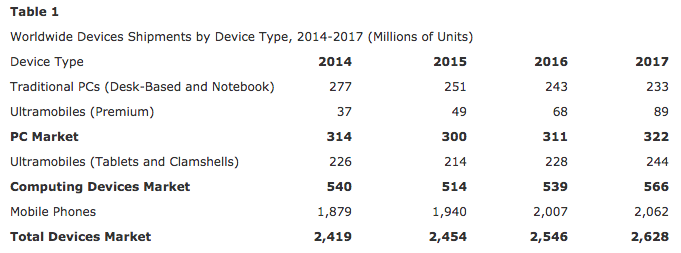
Worldwide device shipments expected to grow 1.5 per cent, to Reach 2.5 billion units in 2015. (Reuters)
The number of electronic gadgets being shipped every year is on a constant rise and will continue to grow until 2017, despite a drop in consumer spending on electronics.
According to latest estimates released by Gartner, we could well be heading towards a glut in the market.
Worldwide device shipments (PCs, tablets, ultramobiles and mobile phones) is expected to grow 1.5 per cent, to Reach 2.5 billion units in 2015.
 However, not everyone is expected to spend on electronics either. The Gartner note also points out that end-user spending on devices will total $606 billion in 2015 and will show, for the first time since 2010, a 5.7 per cent decline in current US dollars.
However, not everyone is expected to spend on electronics either. The Gartner note also points out that end-user spending on devices will total $606 billion in 2015 and will show, for the first time since 2010, a 5.7 per cent decline in current US dollars.
“Our forecast for unit shipment growth for all devices in 2015 has dropped by 1.3 percentage points from last quarter’s estimate,” said Ranjit Atwal, research director at Gartner.
“This was partly due to a continued slowdown in PC purchases in Western Europe, Russia and Japan in particular, largely due to price increases resulting from local currency devaluation against the dollar.”
Also it will be mobile phones that will continue to drive sales and witness growth. The number of mobile phones shipped is set to increase from 1.8 billion in 2014 to 1.94 billion by the end of 2015.
 Compare this to a drop in the numbers of traditional PCs from 277 million in 2014 to 251 million in 2015.
Compare this to a drop in the numbers of traditional PCs from 277 million in 2014 to 251 million in 2015.
The ultramobile and premium category – which includes devices such as Microsoft’s Windows 8 Intel x86 products and Apple’s MacBook Air – is however expected to increase from 37 million to 49 million.
The global PC shipment market is expected to total 300 million units in 2015, a decline of 4.5 per cent year on year.
“We do not expect the global PC market to recover until 2016,” said Atwal.
The release of Windows 10 however could revive replacement sales during 2016.
While the mobile phone segment continues to grow, continuing drop in prices could affect profit margins of most leading firms.
According to Gartner, the emerging markets are driving the smartphone market upward, with China leading the way.
But even within the mobile segment the growth will subdued. The growth rate is expected to slow down to 3.3 per cent growth in 2015. “The global market has been affected by a weaker performance in China. We have witnessed fewer and fewer first time buyers in China, a sign that the mobile phone market in there is reaching saturation. Vendors in China will have to win replacement buyers and improve the appeal of their premium offerings to attract upgrades, if they want to maintain or increase their market share,” said Annette Zimmermann, research director at Gartner.
Unlike mobile phones tablets sales have been dropping since last year, especially on the backdrop of phablet size devices gaining prominence. Apple’s iPhone 6 Plus itself has affected sales of the iPad and the iPad mini. Tablets will account for 207 million units, a decline of 5.9 percent from 2014.
“The tablet market is hit by fewer new buyers, extended life cycles and little innovation to encourage new purchases,” said Roberta Cozza, research director at Gartner.
The tablet – he says – has become a “nice to have” device, and there is no real need for an upgrade as regularly as for the phone.
According to Gartner, users are relying more on their smartphones as functionality increases and screen size standardises at 5 inches. This is affecting the appeal of smaller tablets in markets such as Western Europe and North America, beyond Asia.
[“source – emirates247.com”]







